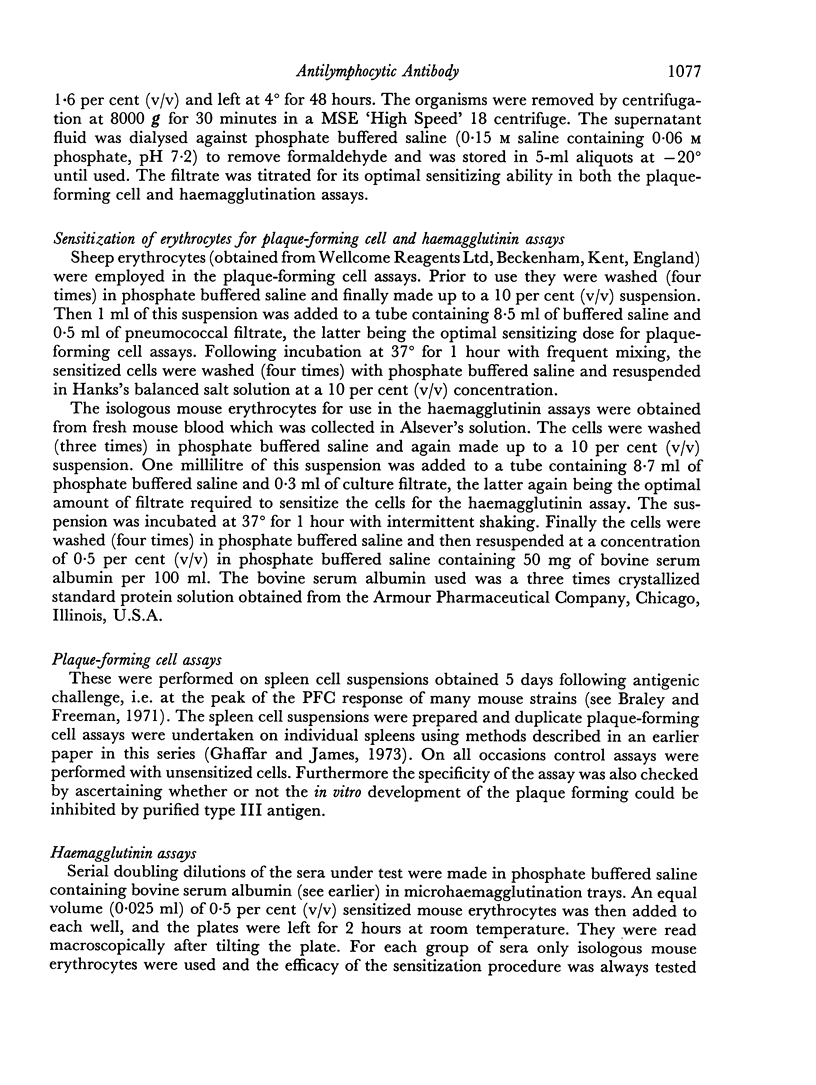Abstract
The effect of a single batch of horse anti-mouse thymocyte globulin on the immune response to type III polysaccharide antigen has been investigated in 2–3-month-old male A/HeJ, C57B1, BALB/c, DBA/1, CBA and C3H mice. In almost all cases the intraperitoneal administration of 5 mg of this material on days –4 and –2 significantly suppressed the immune response to 0.1, 1.0 and 5.0 μg of antigen injected i.v. on day 0. Further studies undertaken in BALB/c mice indicated that effective suppression of the immune response to type III polysaccharide antigen could also be achieved by injecting 5 mg of this product (i.p.) some 15–30 minutes prior to antigenic challenge. Preliminary cell reconstitution studies in antilymphocytic antibody-treated CBA mice indicate that the ability to respond to type III polysaccharide can be partially restored by the injection of syngeneic thymocytes, bone marrow cells or spleen cells.
Full text
PDF










Selected References
These references are in PubMed. This may not be the complete list of references from this article.
- ASKONAS B. A., FARTHING C. P., HUMPHREY J. H. The significance of multiple antibody components in serum of immunized rabbits. Immunology. 1960 Oct;3:336–351. [PMC free article] [PubMed] [Google Scholar]
- Aaskov J. G., Halliday W. J. Requirement for lymphocyte-macrophage interaction in the response of mouse spleen cultures to pneumococcal polysaccharide. Cell Immunol. 1971 Aug;2(4):335–340. doi: 10.1016/0008-8749(71)90068-2. [DOI] [PubMed] [Google Scholar]
- Baker P. J., Barth R. F., Stashak P. W., Amsbaugh D. F. Enhancement of the antibody response to type 3 pneumococcal polysaccharide in mice treated with antilymphocyte serum. J Immunol. 1970 May;104(5):1313–1315. [PubMed] [Google Scholar]
- Baker P. J., Stashak P. W., Amsbaugh D. F., Prescott B., Barth R. F. Evidence for the existence of two functionally distinct types of cells which regulate the antibody response to type 3 pneumococcal polysaccharide. J Immunol. 1970 Dec;105(6):1581–1583. [PubMed] [Google Scholar]
- Barth R. F. Studies on heterologous antilymphocyte and antithymocyte sera. IV. Further evidence for a preferential effect on antigen-sensitive cells. J Immunol. 1969 Oct;103(4):648–654. [PubMed] [Google Scholar]
- Braley H. C., Freeman M. J. Strain differences in the antibody plaque-forming cell responses of inbred mice to pneumococcal polysaccharide. Cell Immunol. 1971 Feb;2(1):73–81. doi: 10.1016/0008-8749(71)90026-8. [DOI] [PubMed] [Google Scholar]
- Davies A. J., Carter R. L., Leuchars E., Wallis V., Dietrich F. M. The morphology of immune reactions in normal, thymectomized and reconstituted mice. 3. Response to bacterial antigens: salmonellar flagellar antigen and pneumococcal plysaccharide. Immunology. 1970 Dec;19(6):945–957. [PMC free article] [PubMed] [Google Scholar]
- HUMPHREY J. H., PARROTT D. M., EAST J. STUDIES ON GLOBULIN AND ANTIBODY PRODUCTION IN MICE THYMECTOMIZED AT BIRTH. Immunology. 1964 Jul;7:419–439. [PMC free article] [PubMed] [Google Scholar]
- Howard J. G., Christie G. H., Courtenay B. M., Leuchars E., Davies A. J. Studies on immunological paralysis. VI. Thymic-independence of tolerance and immunity to type 3 pneumococcal polysaccharide. Cell Immunol. 1971 Dec;2(6):614–626. doi: 10.1016/0008-8749(71)90009-8. [DOI] [PubMed] [Google Scholar]
- James K., Milne I. The effect of anti-lymphocytic antibody on the humoral immune response in different strains of mice. I. The response to bovine serum albumin. Immunology. 1972 Dec;23(6):897–909. [PMC free article] [PubMed] [Google Scholar]
- James K., Milne I. The effect of antilymphocytic antibody on the primary immune response of mice to sheep erythrocytes, bovine serum albumin, and type 3 pneumococcus polysaccharide. Transplantation. 1971 Aug;12(2):109–113. doi: 10.1097/00007890-197108000-00002. [DOI] [PubMed] [Google Scholar]
- Janossy G., Greaves M. F. Lymphocyte activation. II. discriminating stimulation of lymphocyte subpopulations by phytomitogens and heterologous antilymphocyte sera. Clin Exp Immunol. 1972 Mar;10(3):525–536. [PMC free article] [PubMed] [Google Scholar]
- Kerbel R. S., Eidinger D. Variable effects of anti-lymphocyte serum on humoral antibody formation: role of thymus dependency of antigen. J Immunol. 1971 Apr;106(4):917–926. [PubMed] [Google Scholar]
- Lance E. M. The selective action of antilymphocyte serum on recirculating lymphocytes: a review of the evidence and alternatives. Clin Exp Immunol. 1970 Jun;6(6):789–802. [PMC free article] [PubMed] [Google Scholar]
- Martin W. J., Miller J. F. Cell to cell interaction in the immune response. IV. Site of action of antilymphocyte globulin. J Exp Med. 1968 Oct 1;128(4):855–874. doi: 10.1084/jem.128.4.855. [DOI] [PMC free article] [PubMed] [Google Scholar]
- Mitchison N. A. Mechanism of action of antilymphocyte serum. Fed Proc. 1970 Jan-Feb;29(1):222–223. [PubMed] [Google Scholar]


